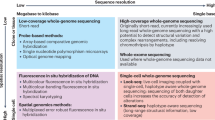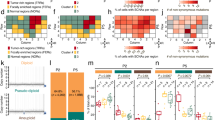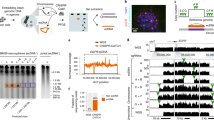Abstract
We have performed microdissection of 16 putative homogeneously staining regions (hsrs) from nine different breast cancer cell lines in order to determine their chromosomal origin and composition. As expected, the most commonly amplified chromosomal band-region was 17q12 (containing ERBB2). However, regions not containing known oncogenes were also identified, including 13q31 (5/9 cases) and 20q12–13.2 (4/9 cases). The chromosomal composition of the integrated amplified DNA within each hsr was determined and in 13/16 cases (81 %), hsrs were shown to be composed of two or more chromosomal regions. These studies shed light on the mechanism of formation of hsrs, and identify chromosomal regions likely to harbour genes amplified in breast cancer.
This is a preview of subscription content, access via your institution
Access options
Subscribe to this journal
Receive 12 print issues and online access
$209.00 per year
only $17.42 per issue
Buy this article
- Purchase on Springer Link
- Instant access to full article PDF
Prices may be subject to local taxes which are calculated during checkout
Similar content being viewed by others
References
American Cancer Society. Cancer Facts and Figures, (Atlanta, Georgia, 1992).
Mitelman, F. Catalog of chromosome aberrations in cancer. 4th edn (Wiley-Liss, New York, 1991).
Devillee, P. & Cornelisse, C. Genetics of human breast cancer. Cancer Survey 9, 605–630 (1990).
Dutrillaux, B., Gerbeault-Seureau, M. & Zafrani, B. Characterization of chromosomal anomalies in human breast cancer. Cancer Genet. Cytogenet. 49, 203–217 (1990).
Saint-Ruf, C. et al. Proto-oncogene amplification and homogeneously staining regions in human breast carcinomas. Genes Chrom. Cancer 2, 18–26 (1990).
Thompson, F. et al. Clonal chromosome abnormalities in human breast carcinomas. Twenty-eight cases with primary disease. Genes Cnrom. Cancer 7, 185–193 (1993).
Trent, J. et al. Clonal chromosome abnormalities in human breast carcinomas II. Thirty-four cases with metastatic disease. Genes Chrom. Cancer 7, 194–203 (1993).
Dutrillaux, B., Gerbault-Seureau, M. & Zafrani, B. Characterization of chromosomal anomalies in human breast cancer. A comparison of 30 paradiploid cases with few chromosome changes. Cancer Genet. Cytogenet. 49, 203–217 (1990).
Saint-Ruf, C., Gerbault-Seureau, M., Viegas-Pequignot, E., Zafrani, B. & Dutrillaux, B. Recurrent homogeneously staining regions in 8p1 in breast cancer and lack of amplification of POLB, LHRH, and PLAT genes. Cancer Genet. Cytogenet. 52, 27–35 (1991).
Ruta, M. et al. A novel protein tyrosine kinase gene whose expression is modulated during endothelial cell differentiation. Oncogene 3, 9–15 (1988).
Escot, C. et al. Genetic alteration of the c-myc protooncogene (MYC) in human primary breast carcinomas. Proc. natn. Acad. Sci. U.S.A. 83, 4834–4838 (1986).
Matteï, M.G. et al. Assignment by in situ hybridization of a fibroblast growth factor receptor gene to human chromosome band 10q26. Hum. Genet. 87, 84–86 (1991).
Lammie, A. & Peters, G. Chromosome 11q13 abnormalities in human cancer. Cancer Cells 3, 413–420 (1991).
Mars, W. & Saunders, G. Chromosomal abnormalities in human breast cancer. Cancer Metast. Rev. 9, 35–43 (1990).
Berns, E.M.J. et al. Sporadic amplification of the Insulin-like Growth Factor 1 Receptor gene in human breast cancer. Cancer Res. 52, 1036–1039 (1992).
Slamon, D., Clark, G., Wong, S., Levin, W., Ullrich, A. & McGuire, W. Human breast cancer: Correlation of relapse and survival with amplificationof HER-2/neu oncogene. Science 235, 177–182 (1987).
Slamon, D.J. et al. Studies of the HER-2/neu proto-oncogene in human breast and ovarian cancers. Science 244, 707–712 (1989).
Meltzer, P.S., Guan, X.-Y., Burgess, A. & Trent, J.M. Rapid generation of region specific probes by chromosome microdissection and their application. Nature Genet. 1, 24–28 (1992).
Guan, X.-Y., Meltzer, P.S., Cao, J., Trent, J.M. Rapid generation of region-specific genomic clones by chromosome microdissection of DNA from a region frequently deleted in malignant melanoma. Genomics 14, 680–684 (1992).
Su, Y.A., Trent, J.M. & Meltzer, P.S Direct isolation of genes encoded within a homogeneously staining region by chromosome microdissection. Proc. natn. Acad. Sci. U.S.A. 91, 9121–9125 (1994).
Zhang, J, Trent, J.M. & Meltzer, P.S. Rapid isolation and characterizatin of amplified DNA by chromosome microdissection: identification of IGR1R amplification in malignant melanoma. Oncogene 8, 2827–2831 (1993).
Trent, J.M. & Thompson, F.H. Methods for chromosome banding of human and experimental tumor in vitro. Meth. Enzymol. 151, 267–279 (1987).
Guan, X-Y., Trent, J.M. & Meltzer, P.S. Generation of band-specific painting probes from a single microdissected chromosome. Hum. molec. Genet. 2, 1117–1121 (1993).
Pinkel, D. et al. Fluorescence in situ hybridization with human chromosome-specific libraries: Detection of trisomy 21 and translocation of chromosome 4. Proc. natn. Acad. Sci. U.S.A. 85, 9138–9142 (1988).
Meltzer, P.S. et al. Establishment of two new cell lines derived from human breast carcinomas with HER-2/neu amplification. Brit. J. Cancer 63, 727–735 (1991).
Cailleau, R. et al. Breast tumor cell lines from pleural effusions. J. natn. Cancer Inst. 53, 661–674 (1974).
Soule, H.D. et al. A human cell line from a pleural effusion derived from a breast carcinoma. J. natn. Cancer Inst. 51, 1409–1416 (1973).
Lasfargues, E.Y., Coutinho, W.G. & Redfield, E.S. Isolation of two human tumor epithelial cell lines from solid breast carcinomas. J. natn. Cancer Inst. 61, 967 (1978).
Lafage, M. et al. Fusion and amplification of two originally non-syntenic chromosomal regions in a mammary carcinoma cell line. Genes Chrom. Cancer 5, 40–49 (1992).
Kallioniemi, A. et al. Detection and mapping of amplified DNA sequences in breast cancer by comparative genomic hybridization. Proc. natn. Acad. Sci. U.S.A. 91, 2156–2160 (1994).
Liang, B.C., Meltzer, P.S., Guan, X-Y. & Trent, J.M. Gene amplification elucidated by combined chromosomal microdissection and comparative genomic hybridization. Cancer Genet. Cytogenet. (in the press).
Author information
Authors and Affiliations
Rights and permissions
About this article
Cite this article
Guan, XY., Meltzer, P., Dalton, W. et al. Identification of cryptic sites of DNA sequence amplification in human breast cancer by chromosome microdissection. Nat Genet 8, 155–161 (1994). https://doi.org/10.1038/ng1094-155
Received:
Accepted:
Issue Date:
DOI: https://doi.org/10.1038/ng1094-155
This article is cited by
-
SOX9 is a key component of RUNX2-regulated transcriptional circuitry in osteosarcoma
Cell & Bioscience (2023)
-
Selection and Application of DNA Aptamer Against Oncogene Amplified in Breast Cancer 1
Journal of Molecular Evolution (2015)
-
A common copy-number breakpoint of ERBB2 amplification in breast cancer colocalizes with a complex block of segmental duplications
Breast Cancer Research (2012)
-
Structural analysis of the genome of breast cancer cell line ZR-75-30 identifies twelve expressed fusion genes
BMC Genomics (2012)
-
Binding of pro-prion to filamin A: by design or an unfortunate blunder
Oncogene (2010)



